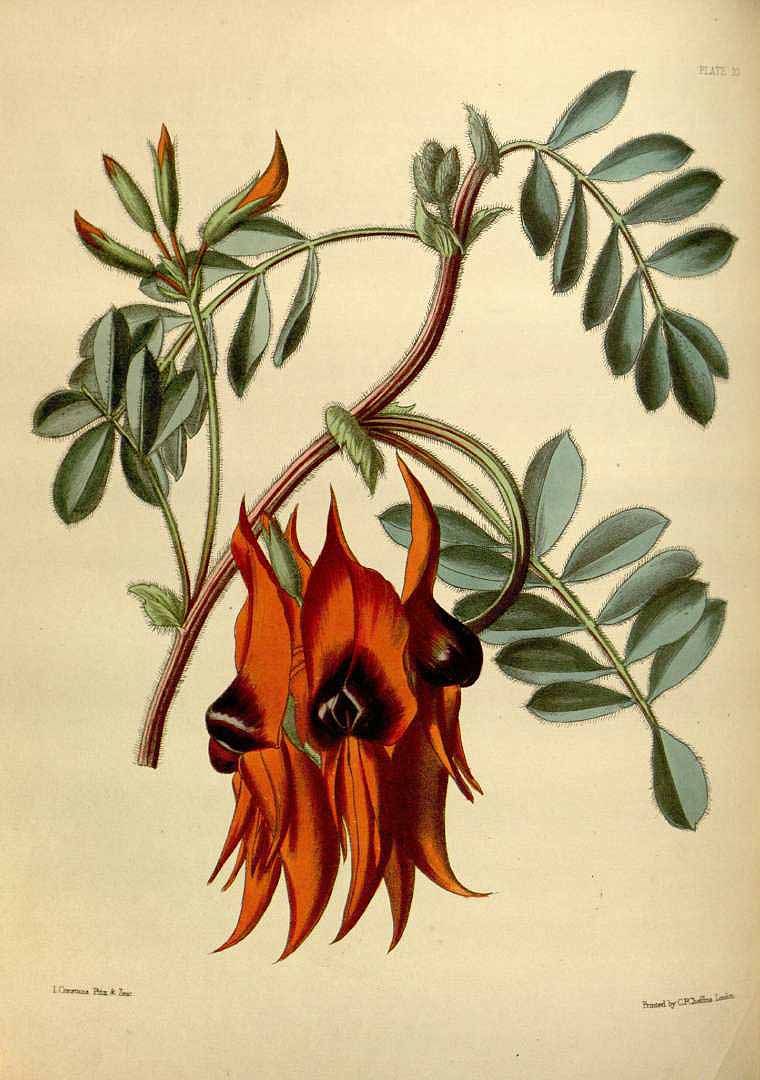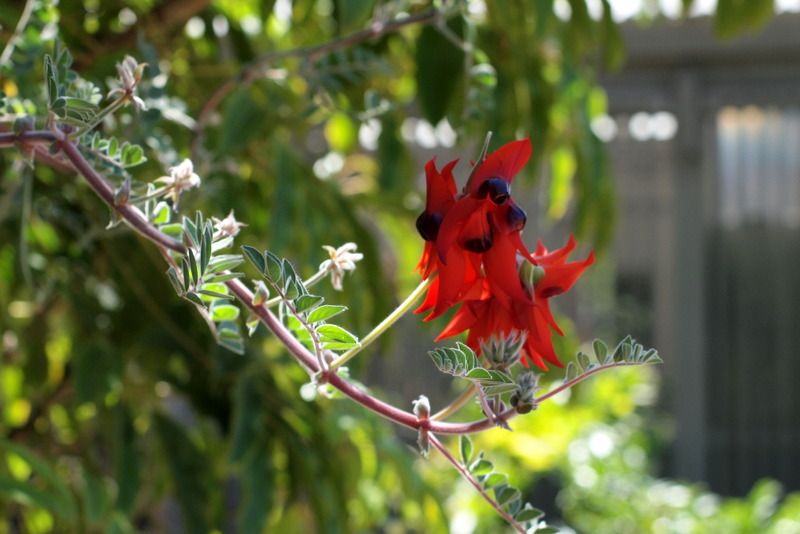I stopped in at the Sherman Gardens recently to check in on the succulent garden, which I visited a couple years ago and wrote about here. Although that garden looks the same as the day I visited, there was a stunning newcomer elsewhere on the grounds, in a couple pots on tall pillars.

Clianthus formosus aka Swainsona formosa, Sturt’s Desert Pea
The brilliant flowers were as noisy as parrots and pulled me in from 50 yards away. I was guessing some kind of erythrina. Up close I could see that the leaves were as subtly beautiful as the flowers were flamboyant. The foliage had the typical, finely cut stamp that all members of the pea family possess, such as lupins, but grey and fuzzy like Dorycnium hirsutum. Offhand, I can’t think of another plant that combines flowers in the colors of the tropics with leaves that would look at home in any mediterranean landscape. The flaming blooms ignite against those pewter leaves, and the red stems spread the flames horizontally. A staff member helped me with the identification but knew little more than a name. She said she noticed them on the truck during a recent plant delivery and grabbed four of them, two for pots, two to trial in the ground.
By this point I already had clianthus penciled in for summer 2014.

Not so fast. I found this description and alarming bit of advice from Chiltern’s, which carries seeds of this clianthus: “A magnificent, semi-procumbent, evergreen sub-shrub with silky-haired, pale grey-green foliage and large scarlet flowers with a bulbous, velvet-black eye. Although it can be grown on its own roots, it then has a habit of dying just before it flowers. However, it has been found that if grafted as a young seedling onto a similar seedling of Colutea arborescens, it grows and blossoms much more freely and lives longer. We therefore offer a packet of each of these together with full instructions to give your green fingers a real test of skill.”
I hate tests of skill.

That it’s tricky to grow explains why a beautiful plant first collected in 1699 is not more commonly seen.

“a creeping vine that runs along the ground … and the blossom like a bean blossom, but much larger and of a deep red colour looking very beautiful.”
— collected by British navigator William Dampier in 1699 on Rosemary Island.
Image found here
The Royal Botanic Gardens, Kew, has a lengthy online description of this striking Australian and doesn’t mention any special growing requirements. The Australian National Botanic Gardens gives both reassuring yet still challenging propagation advice for the floral emblem of South Australia:
“The hard seed coat of Sturt’s Desert Pea inhibits germination. This effect can be overcome by filing or nicking the seed coat away from the ‘eye’ of the seed; alternatively, the seed may be rubbed gently between sheets of sandpaper. Soaking the seed in warm water gives variable results, Boiling water should not be used as it destroys beneficial bacteria on the seed coat. Since the seedlings develop a long tap root and do not tolerate root disturbance, treated seeds should be planted directly into the chosen garden site or container, or alternatively into small pots for transplanting soon after germination.
“Full sun, perfect drainage and protection from snails are essential. Supplementary watering may not be necessary once the seedlings are established. Under ideal conditions flowering commences about four months after germination. Sturt’s Desert Pea is usually treated as an annual but vigorous flowering may result if root crowns survive from one season to the next. Alternatively, it may be grown in large drums, tubs and upright terracotta drainpipes which allow adequate root development.”

Clianthus formosus, Sturt’s Desert Pea, an Australian beauty for the brave and those craving a test of skill. I’ll take mine in a 4-inch pot, please.

Huh. I just saw this at Armstrong’s, $19.95 in a hanging basket. Stunning, yes, but it looked tricky, it exuded the aura of tricky, it vibrated tricky, it whispered “tricky” in my ear. Happy I left it for the more skilled.
At Armstrong?! Someone must have figured out the propagation trick. Maybe tissue culture.
Very nice and new to me as I was only familiar with Clianthus puniceus before.
Interesting to see the similarities and differences from Clianthus puniceus, which must be much easier to propagate since indeed I bought mine in a 4″ pot from Annie’s.
Instructions like this give me the vapors. I’m glad there are people who enjoy these kinds of challenges, though I will never be one of them.
M&G, I think it was the grey foliage that really makes this one speak to me. I always pass on the clianthus in nurseries.
Loree, maybe Annie’s prop. crew will turn their considerable talents to this one.
Heather, I get those vapors too!
I love the antique botanical print you included. Nice touch! As always, I am enjoying your blog. Great work!
Susan
The ‘perfect drainage and protection from snails is essential’ provides the kiss of death here, even if I wished to perform grafting tasks !
I’d looking for this plant, and I’d like to know what Armstrong’s you saw it in. My Mom has fell in love with this plant since seeing it at Sherman Gardens. Need to find it.
DJ, I’ll pass your note along to Hoover. Good luck with the chase!
DJ it was the one in Tustin. I’m sure the Clianthus is long gone by now, but perhaps they can tell you the wholesaler or where you could get one.
Thank you all in my search for the Clianthus, especially Hoover. I contacted Armstrong’s main office and they sent out an email for all stores in my search. They found it in Newport Beach. I’m so thrilled, as I know my Mom will be I’ve found her one (just an early Christmas gift). Take care all and thanks again.